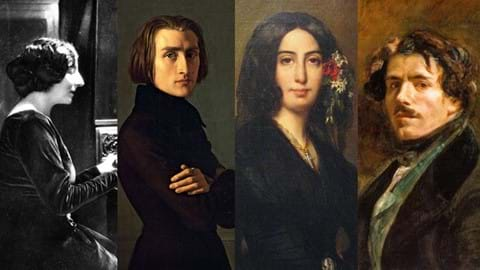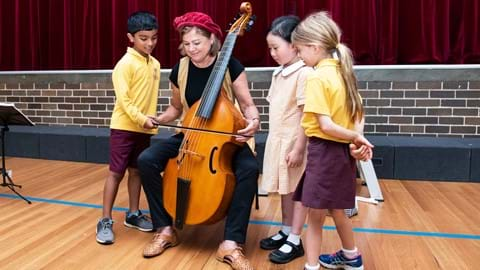Meet the characters of Chopin's Piano
Most music lovers will be familiar with Chopin and his beloved Preludes, but perhaps less well-acquainted with the colourful cast of characters that populated his life at the time of composition. Here’s a cheat sheet that will help get you up to speed, with an introduction to those who figure in the later history of the piano on which Chopin composed his enduring masterpiece.
Together, they form the shining, complex tapestry woven by Chopin’s Piano, Musica Viva Australia’s semi-staged production adapted from Artistic Director Paul Kildea’s book of the same name.
Juan Bauza
The story of Chopin’s Piano begins with Juan Bauza, the local Majorcan craftsman who fashioned the instrument that Chopin would hire to finish composing his 24 Preludes. At the time, Majorcans had little exposure to the development of the pianoforte, which was becoming incredibly popular in mainland Europe in the 1820s and 30s. This meant that Bauza’s piano was a fairly primitive instrument in comparison, but it certainly didn’t stop Chopin from producing some of his very best work. Little else is known about Bauza, but his role in musical history is obviously significant.
George Sand
Born Amantine Lucile Aurore Dupin, George Sand was the most well-known female French novelist of the 19th century. A fascinating, colourful fixture of Parisian life, she was also a noted memoirist and journalist, with forays into the theatre and political sphere, as well as an accomplished draughtsperson and painter. She garnered a slightly dubious reputation based in part on the subject matter of her fiction, which dealt with sexuality, incest, and relationships between the classes. That reputation was exacerbated by her affairs with the well-known figures of her day, chief among them Chopin. In fact, Sand accompanied him on that fateful trip to Majorca with her children, and their relationship was by many accounts artistically collaborative, each supporting the other in their endeavours. They separated two years before his death
Franz Liszt
If you know Chopin, you’re also probably familiar with Liszt, but here’s a quick refresher if you need it. Born in Hungary on October 22, 1811, he was a composer and pianist of astonishing virtuosity. Acknowledged as the first person to give complete solo recitals as a pianist (previously musicians had been expected to share concerts with other performers), he thrilled by performing from memory, playing almost the entire keyboard repertoire as it existed up to then, and drawing massive crowds that were more akin to rock shows. Liszt’s body of work is acknowledged for its originality, and for the way he extended harmonic language and anticipated the atonal music of the 20th century. He became friends with Chopin after the latter’s arrival in Paris and was the dedicatee of Chopin’s Op 10 Études.
Eugene Delacroix
Born in 1798, Eugene Delacroix was the foremost French painter of his day. Widely regarded as the leader of the Romantic movement in 19th century French art, his body of work is notable for its emotionally charged depictions of historical and contemporary events, as well as literary and “exotic” subjects. Delacroix was highly influenced by the great colourist painters of the Venetian Renaissance, as well as his great idol, Rubens. Their influence can be detected in his trademark vivid use of colour and expressive brushwork. Perhaps his most recognisable work is Liberty Leading the People, which commemorates the July Revolution of 1830 which saw the overthrow of King Charles X of France. A friend of Chopin’s, one of his few portraits – unfinished – was of the composer and Sand. Later cut in two, they were sold off as separate pieces after Delacroix’s death.
Wanda Landowska
Born in Warsaw, Poland in 1879, Wanda Landowska was a noted harpsichordist and pianist whose work did much to revive interest in the harpsichord in the early 20th century. She studied in Warsaw, Berlin, and Paris, and by 1912 was teaching harpsichord at the famed Berlin Hochschule für Musik. Her championing of the instrument saw composers such as Manuel de Falla and Francis Poulenc compose harpsichord works for her, and she was the first person to record Bach’s Goldberg Variations on harpsichord. She was a great admirer of Chopin’s and set out in 1911 to Majorca in a pilgrimage to the monastery where Chopin composed his Preludes. It was there she found and acquired the Bauza piano, which she was forced to leave behind in Paris when the Nazis invaded in 1940. Her home was looted, and her collection of instruments, including the piano, were seized by the Nazis. Landowska meanwhile fled to New York, where she continued teaching and performing to acclaim. It was in July 1946 that the piano and her instruments were finally returned to her home in Paris. Landowska would never be reunited with them, remaining in America until her death in 1959.
Henri Lew
Henri Lew was a Polish folklorist and ethnomusicologist with whom Wanda Landowska eloped and then married in Paris in 1900. He was supportive of her work, and together they collaborated on the writing and publication of a book, La musique ancienne, which explored 17th and 18th century music and its interpretation. He was struck and killed by a car in 1919.
Peggy Guggenheim
Peggy Guggenheim was an American collector and gallerist born in New York in 1898. Involved in the mining and smelting industries, her family were one of the wealthiest in the city. As a way of distinguishing herself from her business-minded relations, she travelled the world collecting art. Among those she championed were Kandinsky, Pollock, and Tanguy, and she had a special taste for Surrealism. When Germany invaded France in 1940, she endeavoured to acquire as many important works as she could in the hope of keeping them from the Nazis.
Brancusi
Constantin Brancusi was a Romanian sculptor, painter and photographer who found fame in France. Considered one of the most important sculptors of the 20th century, he distinguished himself from his peers by carving his work directly from wood or stone or casting from bronze.
Denise Restout
Denise Restout was a French keyboard teacher who also served as assistant, protégé, editor and biographer for Wanda Landowska. She began studying harpsichord with Landowska in 1933, and appeared at her public masterclasses in France, the Netherlands and Strasbourg. Together they fled France during the Nazi advance in 1940 and lived together in America until Landowska’s death. In 1959. Restout inherited her estate, including her papers and instruments, and continued as a teacher until her death in 2004.
Following its successful debut in 2021, Chopin's Piano starring pianist Aura Go and actor Jennifer Vuletic will be back touring nationally in July 2023. Click here for more information and to book your tickets.


